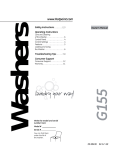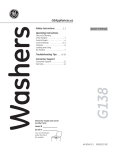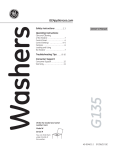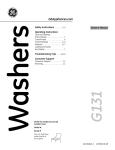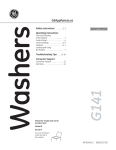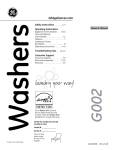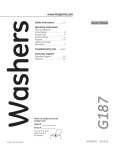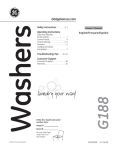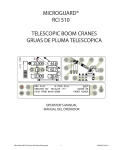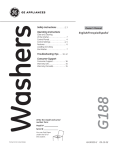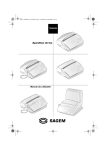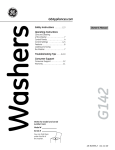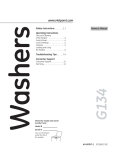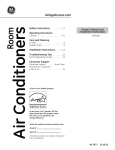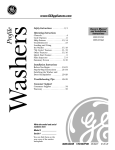Download GE GTWP1800DWW Use and Care Manual
Transcript
Washers
GEAppliances.com
Safety Instructions . . . . . . . . . . 2, 3
Owner’s Manual
Operating Instructions
Care and Cleaning
of the Washer. . . . . . . . . . . . . . . . . . . . . . 7
Control Panels . . . . . . . . . . . . . . . . . . . . . 4
Control Settings . . . . . . . . . . . . . . . . . 4, 5
Features . . . . . . . . . . . . . . . . . . . . . . . . . . . 6
Loading and Using
the Washer . . . . . . . . . . . . . . . . . . . . . . . . 7
Troubleshooting Tips. . . . . . .8–10
Consumer Support
G154
Consumer Support . . . . . . . . . . . . . . . . 12
Warranty. . . . . . . . . . . . . . . . . . . . . . . . . . 11
Write the model and serial
number here:
Model # _____________
Serial # ______________
You can find them
under the lid of
the washer.
49-90435 02-12 GE
WARNING!
For your safety, the information in this manual must be followed to minimize the risk
of fire or explosion, electric shock, or to prevent property damage, personal injury, or
loss of life.
WATER HEATER SAFETY
Under certain conditions, hydrogen gas may be produced in a water heater that has not been
used for two weeks or more. Hydrogen gas can be explosive under these circumstances.
If the hot water has not been used for two weeks or more, prevent the possibility of damage or injury by
turning on all hot water faucets and allowing them to run for several minutes. Do this before using any
electrical appliance which is connected to the hot water system. This simple procedure will allow any
built-up hydrogen gas to escape. Since the gas is flammable, do not smoke or use an open flame or
appliance during this process.
Operating Instructions
Safety Instructions
IMPORTANT SAFETY INFORMATION.
READ ALL INSTRUCTIONS BEFORE USING.
PROPER INSTALLATION
This washer must be properly installed and located in accordance with the Installation
Instructions before it is used. If you did not receive an Installation Instructions sheet, you can
receive one by visiting GEAppliances.com or by calling 800.GE.CARES (800.432.2737).
Install or store where it will not be exposed to
temperatures below freezing or exposed to the
weather, which could cause permanent damage
and invalidate the warranty.
Properly ground washer to conform with all
governing codes and ordinances. Follow details
in Installation Instructions.
Troubleshooting Tips
To ensure proper installation, run two small load
size Whites/Quick Wash cycles BEFORE washing
the first load.
This washer does not include water supply hoses.
GE strongly recommends the use of factory
specified parts. A list of factory hoses available
for purchase are listed below. These hoses
are manufactured and tested to meet GE
specifications.
GE strongly recommends the use of new water
supply hoses. Hoses degrade over time and need
to be replaced every 5 years to reduce the risk of
hose failures and water damage.
Parts and Accessories
Order on-line at GEAppliances.com today, 24
hours a day or by phone at 800.626.2002 during
normal business hours.
Part Number
Accessory
WH41X10207
4 ft Rubber Water Supply Hoses
OR
WX14X10005
4 ft Braided Water Supply Hoses
YOUR LAUNDRY AREA
Consumer Support
Keep the area underneath and around your
appliances free of combustible materials such as
lint, paper, rags, chemicals, etc.
2
Close supervision is necessary if this appliance is
used by or near children. Do not allow children to
play on, with or inside this or any other appliance.
WHEN USING THE WASHER
Never reach into the washer while it is moving.
Wait until the machine has completely stopped
before opening the lid.
solvents, kerosene, etc.). These substances give
off vapors that may ignite or explode. Do not add
these substances to the wash water. Do not use
or place these substances around your washer or
dryer during operation.
To minimize the possibility of electric shock,
unplug this appliance from the power supply
or disconnect the washer at the building’s
distribution panel by removing the fuse or
switching off the circuit breaker before attempting
any maintenance or cleaning.
NOTE: Turning the Cycle Selector Knob to an off
position, or pressing PAUSE does NOT disconnect
the appliance from the power supply.
Never attempt to operate this appliance if it is
damaged, malfunctioning, partially disassembled,
or has missing or broken parts, including a
damaged cord or plug.
WHEN NOT IN USE
Turn off water faucets to minimize leakage if a
break or rupture should occur. Check the condition
of the fill hoses; GE recommends changing the
hoses every 5 years.
Do not tamper with controls.
Troubleshooting Tips
Before discarding a washer, or removing it
from service, remove the washer lid to prevent
children from hiding inside.
Do not attempt to repair or replace any part of
this appliance unless specifically recommended in
this Owner’s Manual, or in published user-repair
instructions that you understand and have the
skills to carry out.
Operating Instructions
Use this
Do not mix chlorine bleach with ammonia or
appliance
acids such as vinegar and/or rust remover. Mixing
only for its
different chemicals can produce a
intended
toxic gas which may cause death.
purpose as
Do not wash or dry articles that have been
described in
cleaned in, washed in, soaked in or spotted with
this Owner’s
combustible or explosive substances (such as
Manual.
wax, oil, paint, gasoline, degreasers, dry-cleaning
The laundry process can reduce the flame
retardancy of fabrics. To avoid such a result,
carefully follow the garment manufacturer’s
wash and care instructions.
Safety Instructions
GEAppliances.com
READ AND FOLLOW THIS SAFETY INFORMATION
CAREFULLY.
SAVE THESE INSTRUCTIONS
Consumer Support
3
About the control panel³for models with ´pull knobµ start.
Step 2
Step 1
$GGGHWHUJHQW
$GGLWHPV
Step 3
Step 4
6HOHFWORDGVL]HDQG
RWKHUZDVKRSWLRQV
&ORVHOLG
3XOONQRE
6HOHFWZDVKF\FOH
$GGGLOXWHGIDEULF
VRIWHQHURQPRGHOV
ZLWKDIDEULF
VRIWHQHUGLVSHQVHU
6HOHFW237,216
4XLFN6WDUW*XLGH
/2$'6,=(
7(03(5$785(
237,216
A
B
C
D
Controls
A
Load Size
Loosely load items in the washer basket. Overloading may negatively impact wash performance. Adjust the load size accordingly.
Reset
If you decide that you want a higher water level, move the Load Size first to Reset and then to the higher water setting.
4
B
Temperature
C
Options (on some models)
Select the water temperature for the wash and rinse cycles. Always follow fabric manufacturer’s care label or instructions when
laundering.
Fabric Softener and Power Rinse
Set this option when adding fabric softener during the rinse cycle or when you use extra detergent or bleach to clean heavily soiled
items. It provides an enhanced second cold rinse.
D
Wash Cycle³Cycle Selector .nob
The chart below will help you match the wash cycle setting with your items. The chart is ranked from greatest to least
wash intensity.
Your washer may not have all these cycles. (Cycles vary by model.)
:+,7(6 For heavy to lightly soiled cottons, household linens, work and play items.
5(*8/$5:$6+)$6763,1
&2/256 For non-colorfast cottons and blends and items that are labeled cold wash.
5(*8/$5:$6+)$6763,1
Safety Instructions
GEAppliances.com
3(50$1(1735(66 For wrinkle-free and permanent press items, and knits.
38/6(':$6+)$6763,1
Operating Instructions
5,16(62$. For rinsing chlorine, perspiration, stains, etc., out of items. (Followed by '5$,1)$6763,1.
'5$,163,1 For draining the tub and spinning water out of the clothes. )$6763,1
Liquid Bleach Funnel
The water fill dilutes liquid chlorine bleach as the washer fills for the wash cycle.
1 Check clothing care labels for special instructions.
2 Measure liquid bleach carefully, following instructions on the bottle.
Never pour undiluted liquid chlorine bleach directly onto clothes or into the wash
basket.
Do not pour powdered bleach into bleach funnel.
3 Before starting the washer, pour measured amount of bleach directly into bleach funnel.
Avoid splashing or over-filling dispenser. If you prefer to use powdered bleach, add it into
the wash basket with your detergent.
Troubleshooting Tips
Do not mix chlorine bleach with ammonia or acids such as vinegar and/or rust
remover. Mixing can produce a toxic gas which may cause death.
FAQ
Q: What is the difference between Heavy and Light settings?
$ For Whites and Colors, the wash agitation time is increased by 6 minutes and for Permanent Press, by 12 minutes.
(Times are approximate)
Q: What is the difference between Regular and Pulsed?
$ Regular means the washer will continuously agitate during the wash cycle. Pulsed provides a more gentle wash
cycle by including pause periods during the wash cycle.
4Which cycle is best for heavily soiled items?
$ Whites or Colors cycles have the greatest wash intensity. This cycle provides the best overall cleaning . Permanent
Press should be used for wrinkle-free and permanent press items.
Q: How much detergent do I use?
$For best performance, always follow the detergent manufacturer’s instructions on usage. Many detergents are
concentrated, so consult the product label and follow the clearly marked lines on the detergent measuring cups.
Excessive detergent can negatively impact the wash performance.
5
Consumer Support
Q: How can I reduce linting?
$ Sort wash loads by fabric type and whether they collect lint (velveteen, corduroy) or produce lint (terry cloth, chenille).
Wash small loads for a shorter amount of time.
Safety Instructions
About washer features.
The Agitator Cap (on some models)
The agitator cap fits into the top of the
agitator. If it accidentally comes off,
simply put it back on.
Fabric Softener Dispenser (on some models)
3 Add water to dispenser until it reaches
the maximum fill line.
Do not stop the washer or raise the lid
during the first spin. This will cause the
dispenser to empty too soon.
OPTIONS
OFF
To use, follow these steps:
Set when adding
FABRIC SOFTENER
and/or POWER RINSE
1 Make sure dispenser is securely attached
to agitator.
Do not pour anything into the
agitator if the agitator cap or
dispenser is removed.
2 Use only diluted liquid fabric softener.
Pour into dispenser, using amount
recommended on package.
Never pour fabric softener directly on items.
It may stain them.
Troubleshooting Tips
Operating Instructions
The fabric softener dispenser automatically
releases liquid fabric softener. Setting the
knob ensures that it dispenses at the proper
time.
4 Select FABRIC SOFTENER setting knob to
activate the cycle.
Note: Fabric softener will not dispense if the
knob is in the “OFF” position.
Cleaning the Fabric Softener Dispenser (on some models)
1 Remove the dispenser from the top of the agitator.
2 Separate the dispenser cup from the cover by grasping the top and pushing down on the
inside of the cup with your fingers. Dispenser cup will pop free from the cover.
3 To clean the dispenser, soak both the dispenser cup and the dispenser cover in the
Separate for cleaning
following solution:
1 US gallon (3.8 liters) warm water
1/4 cup (60 ml) heavy-duty liquid detergent
1 cup (240 ml) bleach
4 If necessary, loosen buildup with a clean, soft cloth after soaking. Do not use a stiff brush;
you may roughen the surface of the dispenser.
Consumer Support
5 Rinse and reassemble dispenser. Place dispenser back on the agitator.
6
GEAppliances.com
Always follow fabric manufacturer’s care label when laundering.
Sorting Wash Loads
Sort by color (whites, lights, colors), soil level,
fabric type (sturdy cottons, easy care, delicates)
and whether the fabric produces lint (terry cloth,
chenille) or collects lint (velveteen, corduroy).
Proper Use of Detergent
For spots, apply pre-treatment to items as
recommended on the product label. Application
should be made in the basket to prevent overspray
which may cause the coloring on the lid or graphics
to fade.
You can use less detergent if you have soft water,
a smaller load or a lightly soiled load.
When using high efficiency or concentrated
detergents, consult the product label to determine
amount required for optimum performance.
Excessive detergent will negatively impact wash
performance.
Operating Instructions
Add detergent before adding items so that the
detergent can work effectively. Using too little or
too much detergent is a common cause of laundry
problems.
Loading the Washer
Load dry items loosely in the washer basket. When
loading wet items, make sure you set the load/water
level high enough to allow the items to move freely.
Water level should just cover the items. To add items
after washer has started, lift the lid and submerge
additional items next to the agitator.
Troubleshooting Tips
Do not wrap long items like sheets or pants
around the agitator.
Do not wash fabrics containing flammable
materials (waxes, cleaning fluids, etc.).
Washer will not agitate or spin with the lid up,
however the timer will continue to run.
Care and cleaning of the washer.
Wash Basket: Leave the lid open after washing to
allow moisture to evaporate. If you want to clean
the basket, use a clean soft cloth dampened with
liquid detergent; then rinse. (Do not use harsh or
gritty cleaners.)
Exterior: Immediately wipe off any spills. Wipe
with damp cloth. Try not to hit surface with
sharp objects.
Moving and Storage: Ask the service technician to
remove water from drain pump and hoses. See the
Installation Instructions packed with product for
information on how to reinstall the shipping rod
to keep the tub stationary when moving the washer.
For more information, visit GEAppliances.com or
call 800.GE.CARES (800.432.2737). Do not store the
washer where it will be exposed to the weather.
Consumer Support
Fill Hoses: GE recommends changing the hoses
every 5 years.
Safety Instructions
Loading and using the washer.
Long Vacations: Be sure water supply is shut off at
faucets. Drain all water from hoses if weather will
be below freezing.
7
Safety Instructions
Before you call for service…
Troubleshooting Tips
Save time and money! Review the charts on the following pages,
or visit GEAppliances.com. You may not need to call for service.
WATER
Possible Causes
What To Do
Too many suds
7RRPXFKGHWHUJHQW
Measure your detergent carefully. Use less soap if you have
soft water, a smaller load or a lightly soiled load.
7\SHRIGHWHUJHQW
Switch to a lower sudsing detergent brand and follow
instructions on package.
6RIWZDWHU
Try less detergent.
8VLQJWRRPXFKGHWHUJHQW
LQZDVKHU
Use less detergent. Use less soap if you have soft water,
a smaller load or a lightly soiled load.
)LOOKRVHVRUGUDLQKRVHLV
LPSURSHUO\FRQQHFWHG
Make sure hose connections are tight at faucets and
rubber washers are installed. Make sure end of drain hose
is correctly inserted in and secured to drain facility.
+RXVHKROGGUDLQPD\
EHFORJJHG
Check household plumbing. You may need to call
a plumber.
'UDLQKRVHORRVH
Make sure drain hose is fully seated in back of washer and
that the two retaining screws are fully seated.
'UDLQKRVHUXEVRQZDOO
Make sure drain hose does not make contact with the wall.
May cause excessive wear on the hose.
&RQVWDQWZDWHUSUHVVXUH
WRWKHILOOKRVHVDWWKH
ZDWHUVRXUFH
Tigh ten hoses at the faucets and turn the water off after
each use.
Check condition of the fill hoses; they should be replaced
every 5 years.
&RROHUZDWHUWHPSHUDWXUHV
SURYLGHLPSURYHGHQHUJ\
HIILFLHQF\
New laundry detergents have been formulated to work
with cooler water temperatures without affecting wash
performance.
:DWHUVXSSO\LVWXUQHGRII
RULPSURSHUO\FRQQHFWHG
Turn both hot and cold faucets fully on and make sure
hoses are connected to correct faucets.
:DWHUYDOYHVFUHHQVDUH
VWRSSHGXS
Turn off the water source and remove the water connection
hoses from the upper back of the washer. Use a brush or
toothpick to clean the screens in the machine. Reconnect
the hoses and turn the water back on.
+RXVHZDWHUKHDWHULV
QRWVHWSURSHUO\
Make sure house water heater is delivering water at
120°F–140°F (48°C–60°C).
Consumer Support
Troubleshooting Tips
Operating Instructions
Water leaks
Water temperature
seems incorrect
Water pumped out before /LGOLIWHGRUF\FOHZDVSXWLQ
cycle is complete
SDXVHIRURYHUKRXUV
Reset cycle.
Water won’t drain
'UDLQKRVHLVNLQNHGRU
LPSURSHUO\FRQQHFWHG
Straighten drain hose and make sure washer is not
sitting on it.
Top of drain outlet should be less than 6 ft (1.8 m)
above floor.
Washer pauses during
wash cycle
7KLVLVQRUPDO
This is normal. The washer alternates between agitate and
soak during some wash cycles to get your clothes cleaner
with less wear.
Washer pauses during
spin cycle
7KLVLVQRUPDO
The washer may pause during the spin cycle to remove
soapy water more efficiently.
8
OPERATION
Possible Causes
What To Do
Washer won’t operate
:DVKHULVXQSOXJJHG
Make sure cord is plugged securely into a working outlet.
:DWHUVXSSO\LVWXUQHGRII
Turn both hot and cold faucets fully on.
&RQWUROVDUHQRWVHWSURSHUO\
Check controls.
/LGLVRSHQ³VDIHW\IHDWXUH
SUHYHQWVDJLWDWLRQDQG
VSLQQLQJZKHQOLGLVXS
Close lid and reset cycle, to the beginning if necessary.
&LUFXLWEUHDNHUIXVHLV
WULSSHGEORZQ
Check house circuit breakers/fuses. Replace fuses or
reset breaker. Washer should have separate outlet.
7LPHUNQREQRWSXOOHG
Pull timer knob.
/LGPDJQHWPLVVLQJ
Call for service.
PERFORMANCE
Possible Causes
What To Do
Clothes too wet
,QFRUUHFWVSLQF\FOH
VHOHFWHG
Make sure the spin cycle selected matches the load you are
washing. Some fabrics will feel wetter when rinsed with cold water.
Colored spots
,QFRUUHFWXVHRIIDEULF
VRIWHQHU
Check fabric softener package for instructions and follow
directions for using dispenser.
Make sure you have selected the Fabric Softener option.
Pretreat stain and rewash.
'\HWUDQVIHU
Sort whites or lightly colored items from dark colors.
1RWHQRXJKGHWHUJHQW
Use more detergent (especially with larger loads).
Be sure to follow detergent manufacturer’s directions.
+DUGZDWHU
Use a water conditioner like Calgon brand or install
a water softener.
:DWHULVQRWKRWHQRXJK
Make sure water heater is delivering water at
120°F–140°F (48°C–60°C).
:DVKHULVRYHUORDGHG
Select load size to match clothes load.
'HWHUJHQWLVQRW
GLVVROYLQJ
Add detergent before you load items.
'\HWUDQVIHU
Sort clothes by color. If fabric label states wash separately,
unstable dyes may be indicated.
&ORWKHVDUHDLURUOLQHGULHG
If you do not dry your clothes with a clothes dryer, your
clothes may retain more lint.
,QFRUUHFWVRUWLQJ
Separate lint producers from lint collectors.
:DVKLQJWRRORQJ
Wash small loads for a shorter time than larger loads.
'HWHUJHQWQRWGLVVROYLQJ
Add detergent before you load items.
Try a liquid detergent.
Use warmer water temperature.
2YHUORDGLQJ
Load clothes loosely in the washer basket. Adjust load size
based on items size and materials.
Make sure load size selected matches clothes load size.
,QFRUUHFWXVHRIIDEULF
VRIWHQHU
Check fabric softener package for instructions
and follow directions for using dispenser.
Make sure you have selected the Fabric Softener option.
Grayed or yellowed
clothes
Lint or residue on
clothes
Troubleshooting Tips
When the machine is manually turned off, the shifter will
disengage the motor before completely shutting down.
If lid is raised before the motor is disengaged, the process will
stop and will resume when lid is closed.
Operating Instructions
Movement inside machine 6KLIWLQJPHFKDQLVPLV
when shut off
GLVHQJDJLQJWKHPRWRU
Safety Instructions
GEAppliances.com
Consumer Support
9
Safety Instructions
Operating Instructions
Troubleshooting Tips
Consumer Support
Before you call for service…
Troubleshooting Tips
PERFORMANCE (cont.)
Possible Causes
What To Do
Pilling
5HVXOWRIQRUPDOZHDURQ
SRO\FRWWRQEOHQGVDQG
IX]]\IDEULFV
While this is not caused by the washer, you can slow the
pilling process by washing garments inside out.
Snags, holes, tears, rips
or excessive wear
3LQVVQDSVKRRNVVKDUS
EXWWRQVEHOWEXFNOHV
]LSSHUVDQGVKDUSREMHFWV
OHIWLQSRFNHWV
Fasten snaps, hooks, buttons and zippers.
Remove loose items like pins, objects in pockets and
sharp buttons.
Turn knits (which snag easily) inside out.
8QGLOXWHGFKORULQHEOHDFK
Check bleach package instructions for proper amount.
Never add undiluted bleach to wash or allow clothes to
come in contact with undiluted bleach.
&KHPLFDOVOLNHKDLUEOHDFKRU Rinse items that may have chemicals on them before
G\HSHUPDQHQWZDYHVROXWLRQ
washing.
Wrinkling
,PSURSHUVRUWLQJ
Avoid mixing heavy items (like work clothes) with light items
(like blouses).
Try a fabric softener.
2YHUORDGLQJRULQFRUUHFW
ZDWHUOHYHO
Load your washer so clothes have enough room to move
freely with water covering all of the clothes.
,QFRUUHFWZDVKDQG
GU\F\FOHV
Match Cycle selection to the type of fabric you are washing
(especially for easy care loads).
5HSHDWHGZDVKLQJLQ
ZDWHUWKDWLVWRRKRW
Wash in warm or cold water.
SOUNDS
Possible Causes
Reason
´Metallic clickingµ
6KLIWHUPHFKDQLVPLV
HQJDJLQJRUGLVHQJDJLQJ
The drive system will engage at the start of agitate and
disengage when agitate is complete. This occurs multiple
times during the wash.
Back and forth ´swooshµ
or light ´clickingµ sound
during agitate
(OHFWULFPRWRUUHYHUVLQJ
GLUHFWLRQ
This machine has a drive system that doesn’t use gears.
This sound is the motor rotating back and forth to clean
your laundry.
´Clickµ when water
stops filling
5HOD\VZLWFK
The relay makes a click sound when activated. The water
level activates the relay and stops filling.
´Clickingµ behind Control
Panel during fill
$XWRPDWLF7HPSHUDWXUH
&RQWURO9DOYH
Two valves mix cold and hot water. The “clicking” is when either
valve turns on or off to raise or lower the fill water temperature.
Water flow changes
during fill
$XWRPDWLF7HPSHUDWXUH
&RQWURO9DOYH
Two valves mix cold and hot water. The flow changes when either
valve turns on or off to raise or lower the fill water temperature.
Motor ´whining upµ or
´coasting downµ in spin
0RWRUUDPSLQJXSGRZQ
GXULQJVSLQF\FOH
The motor will speed up incrementally during the spin cycle.
When spin is complete, it will coast until it stops.
´Hummingµ
:DWHUGUDLQSXPS
The drain pump will make a humming sound when pumping
out water after agitation stops and continue until spin is
complete.
´Gurglingµ
:DWHUGUDLQSXPS
When the pump starts drawing in air, It starts to gurgle.
The washer should then begin spinning and the sound will
continue until it is done spinning.
Washer is noisy
:DVKHULVXQHYHQ
To level the front of the washer, adjust the front leveling legs
by rotating the individual leg in the proper direction for up
or down. To level the back of the washer, lift the back of the
machine 4” (11 cm) and set down.
10
6KLSSLQJURGLVVWLOODVVHPEOHG To remove the shipping rod from the washer, pull the yellow
LQWKHXQLW
tag and remove the attached rod from the bottom right hand
side of the washer.
GE Washer Warranty.
For The Period Of:
One Year
From the date of the
original purchase
Staple your receipt here.
Proof of the original purchase
date is needed to obtain service
under the warranty.
We Will Replace:
Any factory specified part of the washer which fails due to a defect in materials or workmanship.
During this limited one-year warranty, we will also provide, free of charge, all labor and related
service to replace the defective part.
6HUYLFHWULSVWR\RXUKRPHWRWHDFK\RXKRZWRXVH
WKHSURGXFW
,PSURSHULQVWDOODWLRQGHOLYHU\RUPDLQWHQDQFH
)DLOXUHRIWKHSURGXFWLILWLVDEXVHGPLVXVHGRU
XVHGIRURWKHUWKDQWKHLQWHQGHGSXUSRVHRUXVHG
FRPPHUFLDOO\
5HSODFHPHQWRIKRXVHIXVHVRUUHVHWWLQJRIFLUFXLW
EUHDNHUV
3URGXFWVZKLFKDUHQRWGHIHFWLYHRUEURNHQRUZKLFKDUH
ZRUNLQJDVGHVFULEHGLQWKH2ZQHU·V0DQXDO
'DPDJHWRWKHSURGXFWFDXVHGE\DFFLGHQWILUHIORRGV
RUDFWVRI*RG
,QFLGHQWDORUFRQVHTXHQWLDOGDPDJHFDXVHGE\SRVVLEOH
GHIHFWVZLWKWKLVDSSOLDQFH
'HIHFWVRUGDPDJHGXHWRRSHUDWLRQLQIUHH]LQJ
WHPSHUDWXUHV
'DPDJHFDXVHGDIWHUGHOLYHU\
3URGXFWQRWDFFHVVLEOHWRSURYLGHUHTXLUHGVHUYLFH
This warranty is extended to the original purchaser and any succeeding owner for products purchased for home use within the
USA. If the product is located in an area where service by a GE Authorized Servicer is not available, you may be responsible for a
trip charge or you may be required to bring the product to an Authorized GE Service location. In Alaska, the warranty excludes the
cost of shipping or service calls to your home.
If you need to order replacement parts, we recommend that you only use GE factory specified parts. These parts are designed to
work with your appliance and are manufactured and tested to meet GE specifications.
Some states do not allow the exclusion or limitation of incidental or consequential damages. This warranty gives you specific legal
rights, and you may also have other rights which vary from state to state. To know what your legal rights are, consult your local
or state consumer affairs office or your state’s Attorney General.
Troubleshooting Tips
E;CLUSION OF IMPLIED WARRANTIES³Your sole and exclusive remedy is product repair as provided in this Limited
Warranty. Any implied warranties, including the implied warranties of merchantability or fitness for a particular
purpose, are limited to one year or the shortest period allowed by law.
Operating Instructions
What Is Not Covered:
Safety Instructions
All warranty service provided by our Factory Service Centers,
or an authorized Customer Care® technician. To schedule service,
on-line, visit us at GEAppliances.com, or call 800.GE.CARES
(800.432.2737). Please have serial number and model number
available when calling for service.
Warrantor: General Electric Company. Louisville, .Y 40225
Consumer Support
11
Consumer Support.
GE Appliances Website
GEAppliances.com
Have a question or need assistance with your appliance? Try the GE Appliances Website 24 hours a day,
any day of the year! For greater convenience and faster service, you can now download Owner’s Manuals,
order parts or even schedule service on-line.
Schedule Service
GEAppliances.com
Expert GE repair service is only one step away from your door. Get on-line and schedule your service at
your convenience any day of the year! Or call 800.GE.CARES (800.432.2737) during normal business hours.
Real Life Design Studio
GEAppliances.com
GE supports the Universal Design concept³products, services and environments that can be used by
people of all ages, sizes and capabilities. We recognize the need to design for a wide range of physical and
mental abilities and impairments. For details of GE’s Universal Design applications, including kitchen design
ideas for people with disabilities, check out our Website today. For the hearing impaired, please call 800.TDD.
GEAC (800.833.4322).
Extended Warranties
GEAppliances.com
Purchase a GE extended warranty and learn about special discounts that are available while your warranty
is still in effect. You can purchase it on-line anytime, or call 800.626.2224 during normal business hours.
GE Consumer Home Services will still be there after your warranty expires.
Parts and Accessories
GEAppliances.com
Individuals qualified to service their own appliances can have parts or accessories sent directly to their homes
(VISA, MasterCard and Discover cards are accepted). Order on-line today, 24 hours every day or by phone
at 800.626.2002 during normal business hours.
If you need to order replacement parts, we recommend that you only use GE factory specified parts. These
parts are designed to work with your appliance and are manufactured and tested to meet GE specifications.
Instructions contained in this manual cover procedures to be performed by any user. Other servicing
generally should be referred to qualified service personnel. Caution must be exercised, since improper
servicing may cause unsafe operation.
Contact Us
GEAppliances.com
If you are not satisfied with the service you receive from GE, contact us on our Website with all the details
including your phone number, or write to:
General Manager, Customer Relations
GE Appliances, Appliance Park
Louisville, KY 40225
Register Your Appliance
GEAppliances.com
5HJLVWHU\RXUQHZDSSOLDQFHRQOLQH³DW\RXUFRQYHQLHQFH Timely product registration will allow for
enhanced communication and prompt service under the terms of your warranty, should the need arise.
You may also mail in the pre-printed registration card included in the packing material.
12
Printed in the United States
Instrucciones
de seguridad . . . . . . . . . . . . . . . . . . 2, 3
Manual del
propietario
Instrucciones de operación
Ajustes de control . . . . . . . . . . . . . . . 4, 5
Cómo cargar y usar
la lavadora . . . . . . . . . . . . . . . . . . . . . . . . . 7
Cuidado y limpieza
de la lavadora. . . . . . . . . . . . . . . . . . . . . . 7
Funciones . . . . . . . . . . . . . . . . . . . . . . . . . . 6
Panel de control. . . . . . . . . . . . . . . . . . . . 4
Consejos para la solución
de problemas . . . . . . . . . . . . . . . . 8-10
Soporte al consumidor
Garantía . . . . . . . . . . . . . . . . . . . . . . . . . . 11
Soporte al consumidor . . . . . . . . . . . . 12
G154
Lavadoras
GEAppliances.com
Escriba el número de modelo
y de serie aquí:
No. de modelo _____________
No. de serie _______________
Puede encontrarlos
bajo la puerta
de la lavadora.
49-90435
02-12 GE
INFORMACIÓN DE SEGURIDAD IMPORTANTE.
LEA TODAS LAS INSTRUCCIONES ANTES DE USAR.
Seguridad
¡ADVERTENCIA!
Por su seguridad, debe seguir las indicaciones de este manual para
minimizar el riesgo de incendio o explosión, descarga eléctrica, o para
evitar daños a la propiedad, lesiones personales, o muerte.
SEGURIDAD DEL CALENTADOR DE AGUA
En determinadas condiciones, en un calentador de agua que no se haya utilizado durante un mínimo
de dos semanas se puede producir gas hidrógeno. El gas hidrógeno puede resultar explosivo en
determinadas circunstancias.
Si el agua caliente no se ha utilizado por dos semanas o más, prevenga la posibilidad de sufrir daños o lesiones
abriendo todos los grifos de agua caliente y dejándola correr durante varios minutos. Realice este proceso antes
de utilizar cualquier electrodoméstico que se conecte al sistema de agua caliente. Este sencillo procedimiento le
permitirá liberar todo el gas hidrógeno acumulado. Debido a que el gas es inflamable, no fume ni utilice ninguna
llama o electrodoméstico durante el proceso.
Operación
INSTALACIÓN CORRECTA
La lavadora se debe instalar y colocar correctamente de acuerdo con las instrucciones de instalación,
antes de utilizarla. Si no recibió la hoja con instrucciones de instalación, puede obtener una
visitando GEAppliances.com o llamando al 800.GE.CARES (800.432.2737).
Instale o almacene la lavadora en un lugar donde
no esté expuesta a temperaturas bajo cero ni a las
inclemencias climáticas, ya que esto puede provocar
daños irreversibles e invalidar la garantía.
Esta lavadora no incluye mangueras de suministro
de agua.
GE recomienda enfáticamente el uso de piezas
especificadas de fábrica. A continuación se
encuentra una lista de mangueras de fábrica
disponibles para la compra. Estas mangueras
están fabricadas y probadas para cumplir con las
especificaciones de GE.
Solucionar problemas
Conecte correctamente a tierra la lavadora de
conformidad con todos los códigos y ordenanzas
regulatorias. Siga la información de Instrucciones
de instalación.
GE recomienda enfáticamente el uso de mangueras
nuevas de suministro de agua. Las mangueras se
desgastan con el tiempo y deben reemplazarse
cada 5 años para reducir el riesgo de fallas en las
mangueras y daños provocados por el agua.
Para asegurar una instalación adecuada, deje
correr dos ciclos de Whites/Quick Wash (Lavado
con Ropa Blanca/Rápido) con tamaño de carga
pequeña ANTES de realizar el primer lavado.
Piezas y accesorios
Solicítelos on-line hoy mismo a GEAppliances.com,
las 24 horas del día o por teléfono al 800.626.2002
en horario normal de trabajo.
Número de Pieza
Accesorio
WH41X10207
Mangueras de goma
de suministro de agua
de 4 pies
Soporte al consumidor
O
WX14X10005
Mangueras trenzada
de suministro de agua
de 4 pies
ZONA DE LAVADERO
Mantenga la zona por debajo y alrededor
de sus electrodomésticos libres de materiales
combustibles como pelusa, papel, trapos,
productos químicos, etc.
2
Es necesario vigilar con atención a los niños
si utilizan la lavadora o se encuentran en las
proximidades. No deje que los niños jueguen sobre
éste u otro electrodoméstico, con él o en su interior.
GEAppliances.com
Nunca introduzca las manos en la lavadora
mientras ésta se encuentre en movimiento.
Espere a que la máquina se haya detenido por
completo antes de abrir la tapa.
Utilice este
electrodoméstico No mezcle blanqueadores clorados con amoníaco
sólo para el uso
o ácidos como vinagre o desoxidantes. La mezcla
que se describe
de distintos productos químicos puede producir
en este manual
gases tóxicos que pueden causar la muerte.
del propietario.
Para minimizar la posibilidad de descarga eléctrica,
desenchufe el electrodoméstico de la corriente o
desconecte la lavadora en el panel de distribución
de la vivienda quitando el fusible o apagando el
interruptor antes de realizar cualquier tarea de
mantenimiento o limpieza.
NOTA: El llevar la perilla selectora de ciclo a la
posición OFF u oprimir PAUSE NO desconecta
el electrodoméstico de la alimentación.
No intente en ningún caso utilizar la lavadora
si está dañada, funciona incorrectamente, está
parcialmente desmontada, le faltan piezas o
algunas están rotas, incluidos el cable o el enchufe.
Operación
No lave ni seque prendas que se hayan limpiado,
lavado, empapado o manchado con sustancias
inflamables o explosivas (como cera, aceite,
pintura, gasolina, desengrasantes, disolventes
de limpieza en seco, queroseno, etc.) que puedan
prenderse o explosionar. No añada ninguna de
estas sustancias al agua de lavado. No utilice
ni coloque ninguna de estas sustancias en torno
a la lavadora o la secadora durante el
funcionamiento.
El proceso de lavado puede reducir el tiempo
previo a la inflamación de los tejidos. Para evitar
este efecto, siga con atención las instrucciones de
lavado y cuidado del fabricante de la prenda.
Seguridad
AL UTILIZAR LA LAVADORA
CUANDO NO ESTÉ EN USO
Antes de deshacerse de una lavadora o de
desecharla, quite la puerta de la lavadora para
evitar que los niños se escondan en su interior.
No intente reparar ni sustituir ninguna pieza
de este electrodoméstico, a menos que se
recomiende de manera explícita en el manual del
propietario o en instrucciones publicadas de uso
y reparación que sean comprensibles y que pueda
realizar usted.
Solucionar problemas
Cierre las llaves de paso minimizar las fugas en
caso de que se produzca una rotura o grieta.
Compruebe el estado de las mangueras de llenado;
GE recomienda el cambio de las mangueras cada
5 años.
No manipule los controles.
LEA Y SIGA ESTA INFORMACIÓN
DE SEGURIDAD CUIDADOSAMENTE.
CONSERVE ESTAS INSTRUCCIONES
Soporte al consumidor
3
Panel de control³para modelos que empieza con una perilla.
Paso 2
Paso 1
Paso 3
$JUHJXHODVSUHQGDV
$JUHJXHHOGHWHUJHQWH
Paso 4
6HOHFFLRQHHOWDPDxRGHFDUJD\
RWUDVRSFLRQHVGHODYDGR
&LHUUHODSXHUWD
7LUHODSHULOOD
6HOHFFLRQHHOFLFORGHODYDGR
$JUHJXHHOVXDYL]DQWH
GLOXLGRHQPRGHORV
con dosificador para
VXDYL]DQWH
6HOHFFLRQH237,216
*XtDUiSLGD
/2$'6,=(
7(03(5$785(
237,216
A
B
C
D
Controles
A
Tamaño de carga
Agregue las prendas sin apretar en el tambor de la lavadora. Sobrecargar el tambor puede producir un
impacto negativo en el desempeño de lavado. Ajuste el tamaño de la carga según corresponda.
Reiniciar
Si decide que desea un nivel de agua superior, primero mueva Load Size (Tamaño de Carga) a Reset (Reiniciar)
y luego a la configuración de agua superior.
B
Temperatura
C
Opciones (en algunos modelos)
Seleccione la temperatura del agua para los ciclos de lavado y enjuague. Cuando realice el lavado, observe
siempre las instrucciones o rótulos de cuidados del fabricante del tejido.
Fabric Softener (Suavizante de Telas) y Power Rinse (Enjuague Intenso)
Configure esta opción cuando agregue suavizante de telas durante el ciclo de enjuague o cuando se
utiliza detergente o blanqueador extra para limpiar prendas muy sucias. Brinda un enjuague en frío
mejorado.
4
GEAppliances.com
Ciclo de lavado³perilla selectora del ciclo
La tabla siguiente lo ayudará a combinar la configuración de ciclo de lavado con sus prendas. La tabla está clasificada
de mayor a menor intensidad de lavado.
Su lavadora no puede tener todos estos ciclos. (Los ciclos varían según el modelo.)
:+,7(6523$%/$1&$ Para prendas, ropa de cama, de trabajo y de juego de algodón muy o medianamente sucias.
/$9$'2&20Ò1&(175,)8*$'25È3,'2
Seguridad
D
&2/256&2/25(6 Para prendas de algodón que se pueden desteñir y combinaciones y prendas marcadas para
lavado en agua fría./$9$'2&20Ò1&(175,)8*$'25È3,'2
3(50$1(1735(6635(6,Ï13(50$1(17( Para prendas sin arrugas y con planchado permanente y ropa de punto.
38/6('&(175,)8*$'25È3,'2
5,16(63,1&(175,)8*$5(1-8$*$5 Para enjuagar rápidamente blanqueador, transpiración, manchas, etc. de las
prendas. &(175,)8*$'25È3,'2
'5$,163,1'5(1$-(<*,52 Para drenar el tubo y el agua que gira de la ropa. (GIRO RÁPIDO)
Embudo para el blanqueador líquido
El llenado de agua diluye el blanqueador líquido con cloro a medida que se va llenando para
el ciclo de lavado.
1 Lea las etiquetas de cuidado de las prendas para determinar si hay instrucciones especiales.
Operación
5,16(62$.(1-8$*8(<5(02-2 Para eliminar cloro, transpiración, manchas, etc. de las prendas a través del
enjuague. (Seguido de DRAIN & SPIN (DRENAJE Y GIRO RÁPIDO))
2 Mida la cantidad de blanqueador líquido con todo cuidado siguiendo las instrucciones de
Preguntas Frecuentes
P: ¿Cuál es la diferencia entre las configuraciones Heavy (fuerte) y Light (suave)?
5 Para Whites (ropa blanca) o Colors (Colores), el tiempo de agitación de lavado aumenta en 6 minutos y para
Permanent Press (Presión Permanente) en 12 minutos. (Los tiempos son aproximados).
Solucionar problemas
3
la botella.
No vierta nunca blanqueador líquido con cloro sin diluir directamente sobre la ropa ni
en el cesto de lavado.
No vierta blanqueador en polvo en el embudo del blanqueador.
Antes de encender la lavadora, vierta la cantidad medida de blanqueador directamente
en el embudo. Evite salpicar o llenar el dosificador en exceso. Si prefiere usar blanqueador
en polvo, agréguelo en el cesto de lavado con su detergente.
No mezcle blanqueador con cloro con amoníaco o ácidos como vinagre y/o removedor de
óxido. La mezcla de químicos distintos puede producir un gas tóxico que cause la muerte.
3¿Cuál es la diferencia entre Regular (común) y Gentle (suave)?
5Común significa que la lavadora realizará la agitación con intensidad normal durante el ciclo de lavado. El ciclo
suave brinda un lavado más suave y velocidades menores.
3¿Cómo puedo reducir la producción de pelusa?
5Separe las cargas de lavado por el tipo de tela y por si juntan pelusa (velvetón, corderoy) o producen pelusa (tela de
toalla, felpilla). Lave cargas pequeñas durante períodos de tiempo menos prolongados.
3¿Cuánto detergente debo usar?
5 Para un mejor desempeño, siempre siga las instrucciones de uso del fabricante del detergente. Muchos detergentes
son concentrados, así que debe consultarse la etiqueta del producto y respetarse las líneas marcadas de las tazas de
medición del detergente. Una cantidad excesiva de detergente puede tener un impacto negativo en el desempeño de
lavado.
5
Soporte al consumidor
3¿Qué ciclo es el mejor para prendas muy sucias?
5El ciclo Whites (ropa blanca) o Colors (Colores) posee la mayor intensidad de lavado. Este ciclo ofrece la mejor
limpieza total. El ciclo Permanent Press (Presión Permanente) debe usarse para prendas libres de arrugas y planchado
permanente.
Funciones de la lavadora.
Seguridad
La tapa del agitador o dosificador del suavizante (dependiendo del modelo)
La tapa del agitador entra en la parte superior del agitador. Si se sale accidentalmente,
simplemente vuelva a colocarla en su lugar.
Dosificador de suavizante de telas (dependiendo del modelo)
El dosificador de suavizante de telas libera
automáticamente el suavizante líquido
para telas. Configurar la perilla garantiza la
dosificación en el momento adecuado.
3 Agregue agua al dosificador hasta que
llegue a la línea de llenado máximo.
No detenga la lavadora o levante la tapa
durante el primer centrifugado. Esto hará
que el dosificador se vacíe muy pronto.
Para usarlo, siga estos pasos:
1 Asegúrese de que el dosificador esté
Operación
OPTIONS
OFF
bien adherido al agitador.
Set when adding
FABRIC SOFTENER
and/or POWER RINSE
2 Utilice sólo suavizante de telas líquido
diluido. Viértalo en el dosificador,
utilizando la cantidad recomendada en el
paquete.
4 Seleccione la perilla de configuración de
SUAVIZANTE DE TELAS para activar el
ciclo.
Nota: El suavizante de telas no se dosificará
si la perilla se encuentra en la posición “OFF”
(apagado).
Limpieza del dosificador de suavizante (en algunos modelos)
1 Retire el dosificador de la parte superior del agitador.
2 Separe la taza dosificadora de la cubierta tomando la parte superior y empujando con sus
dedos hacia abajo, en el interior de la taza. La taza dosificadora se liberará de la cubierta.
3 Para limpiar el dosificador, remoje la taza y la cubierta dosificadora en la siguiente solución:
1 galón (3,8 litros) de agua caliente
1/4 taza (60 ml) de detergente líquido reforzado
1 taza (240 ml) de blanqueador
Separe para la limpieza
4 Si es necesario, reduzca la acumulación con un paño suave y limpio después del remojo.
No utilice un cepillo duro; podría dañar la superficie del dosificador.
5 Enjuague y vuelva a montar el dosificador. Vuelva a colocarlo sobre el agitador.
Soporte al consumidor
Solucionar problemas
Nunca vierta suavizante de telas
directamente sobre la ropa. Éstas podrían
mancharse..
No vierta nada en el agitador si
se retira la tapa del agitador o el
dosificador.
6
Cómo cargar y usar la lavadora.
GEAppliances.com
Siempre siga las instrucciones del fabricante de la ropa cuando lave.
Seguridad
Separación de cargas
Separe por color (blancos, claros, colores), nivel de
suciedad, tipo de tela (algodones rústicos, limpieza
fácil, delicados) y si la tela produce pelusa (tela de
toalla, felpilla) o junta pelusa (terciopelo, pana).
Uso correcto del detergente
Agregue el detergente antes de colocar las prendas
para que el detergente pueda funcionar en forma
efectiva. Usar muy poca o mucha cantidad de
detergente es una causa común de problemas de
lavado.
Cuando utilice detergentes de alta eficiencia o
concentrados, consulte la etiqueta del producto
para determinar la cantidad requerida para un
desempeño óptimo. Una cantidad excesiva de
detergente puede tener un impacto negativo en el
desempeño de lavado.
Operación
Para tratar manchas, aplique pretratamiento a las
prendas según se recomienda en la etiqueta del
producto. La aplicación debe realizarse en el tambor
para evitar una pulverización excesiva que podría
provocar que los colores de la tapa o de los gráficos
pierdan su intensidad.
You can use less detergent if you have soft water,
a smaller load or a lightly soiled load.
Carga de la lavadora
No envuelva prendas largas como sábanas
o pantalones alrededor del agitador.
No lave telas que contengan materiales inflamables
(como cera, líquidos limpiadores, etc.).
La agitación no comenzará si la puerta está
levantada.
Cuidado y limpieza de la lavadora.
Mangueras de llenado: GE recomienda el cambio
de las mangueras cada 5 años.
Exterior: Seque los derrames de inmediato. Séquelos
con un paño húmedo. Evite golpear la superficie con
objetos cortantes.
Traslado y almacenamiento: Pídale al técnico
de servicio que elimine el agua de la bomba y
las mangueras. Consulte las instrucciones de
instalación que se incluyen con el producto para
recibir información sobre cómo reinstalar la varilla
de embarque para mantener el cesto metálico
estacionario cuando se cambie la lavadora de lugar.
Para mayor información, visite GEAppliances.com
o llame al 800.GE.CARES (800.432.2737). No guarde
la lavadora donde pudiera quedar expuesta a las
condiciones climáticas.
Vacaciones prolongadas: Asegúrese de cerrar la
provisión de agua en los grifos. Drene toda el agua
de las mangueras si la temperatura llegará a valores
inferiores a cero.
7
Soporte al consumidor
Cesto de lavado: Deje la tapa abierta después
de lavar para que se evapore la humedad. Si
desea limpiar el cesto, use un paño suave y limpio
empapado en detergente líquido; luego enjuáguelo.
(No use limpiadores duros.)
Solucionar problemas
Agregue las prendas secas sin apretar en el tambor
de la lavadora. Cuando cargue prendas húmedas,
asegúrese de establecer
el nivel de agua/carga lo suficientemente alto para
que las prendas se muevan con libertad. El nivel
de agua apenas debe cubrir la ropa. Para agregar
prendas después de que la lavadora haya arrancado,
levante la puerta y sumerja las prendas adicionales
junto al agitador.
Seguridad
Antes de llamar para solicitar servicio…
Consejos para la solución de problemas
¡Ahorre tiempo y dinero! Consulte primero las tablas de las páginas siguientes o
visite GEAppliances.com y quizás no necesite llamar al servicio.
AGUA
Causas posibles
Qué hacer
Demasiada espuma
'HPDVLDGRGHWHUJHQWH
Mida el detergente con cuidado. Use menos jabón si tiene agua
blanda, una carga más liviana o ropa poco sucia.
7LSRGHGHWHUJHQWH
Cambie a una marca de detergente que haga menos espuma
y siga las instrucciones en el envase.
$JXDEODQGD
Pruebe con menos detergente.
'HPDVLDGRGHWHUJHQWH
en la lavadora
Use menos detegente. Use menos jabón si tiene agua blanda,
una carga más liviana o ropa poco sucia.
/DPDQJXHUDGHOOHQDGR
RODGHGHVDJHHVWiPDO
FRQHFWDGD
Asegúrese de que las conexiones de la manguera estén firmes
en los grifos y que las arandelas de goma estén instaladas.
Asegúrese de que el extremo de la manguera de desagüe
esté insertado como corresponde y bien seguro al desagüe.
Fugas de agua
Soporte al consumidor
Solucionar problemas
Operación
(OGHVDJHGHODFDVDHVWiWDSDGR Examine la tubería de la casa. Tendrá que llamar al fontanero.
0DQJXHUDGHGHVDJHIORMD
Asegúrese de que la manguera de desagüe esté bien
colocada en la parte trasera de la lavadora y que los dos
tornillos de retención se encuentren firmemente instalados.
/DPDQJXHUDGHGHVDJH
roza la pared
Asegúrese de que la manguera de desagüe no haga
contacto con la pared. Esto puede provocar un desgaste
excesivo en la manguera.
3UHVLyQGHDJXDFRQVWDQWH
DODVPDQJXHUDVGHOOHQDGR
HQODIXHQWHGHDJXD
Ajuste las mangueras a los grifos y cierre el agua después
de cada uso.
Verifique la condición de las mangueras de llenado; se deben
reemplazar cada 5 años.
7HPSHUDWXUDVPiVIUtDV
GHODJXDSURSRUFLRQDQ
PD\RUHILFLHQFLDHQHUJpWLFD
Se han formulado nuevos detergentes para colada que
trabajan con temperaturas más frías del agua sin afectar
el rendimiento del lavado.
/DSURYLVLyQGHDJXDHVWi
FHUUDGDRPDOFRQHFWDGD
Abra los grifos de agua caliente y fría y asegúrese de que
las mangueras están conectadas a los grifos correctos.
/RVILOWURVGHPDOODGH
ODYiOYXODGHDJXDHVWiQ
WDSDGRV
Cierre la fuente de agua y retire las mangueras de conexión de
agua de la parte superior trasera de la lavadora. Use un cepillo o
mondadientes para limpiar los filtros de malla de la lavadora.
Vuelva a conectar las mangueras y abra el agua de nuevo.
(OFDOHQWDGRUGHDJXDGH
ODFDVDQRHVWiFRQILJXUDGR
FRUUHFWDPHQWH
Asegúrese de que el calentador esté suministrando agua
a 120°F–140°F (48°C–60°C).
Agua bombeada antes
de completarse el ciclo
/DSXHUWDHVWiOHYDQWDGDR
HOFLFORVHSXVRHQSDXVDSRU
PiVGHKRUDV
Reconfigure el ciclo.
El agua no drena
/DPDQJXHUDGHGHVDJH
Enderece la manguera de desagüe y asegúrese de que
HVWiGREODGDRPDOFRQHFWDGD la lavadora no esté apoyada sobre ella.
La parte superior de la salida del desagüe debe estar
a menos de 8 pies (2,5 m) por encima del piso.
La temperatura del agua
parece incorrecta
La lavadora hace una pausa (VWRHVQRUPDO
durante el ciclo
de lavado
Esto es normal. La lavadora alterna entre agitar y remojer
durante algunos ciclos de lavado para que sus prendas se
limpien mejor con menos desgaste.
La lavadora se interrumpe (VWRHVQRUPDO
durante el ciclo de
centrifugado
La lavadora puede hacer pausas durante el ciclo de
centrifugado para eliminar el agua jabonosa con más
eficiencia.
8
GEAppliances.com
OPERACIÓN
Qué hacer
/DODYDGRUDQRHVWiHQFKXIDGD
Asegúrese de que el cable esté bien enchufado a
un tomacorriente que funcione.
/DIXHQWHGHDJXDHVWiFHUUDGD
Abra por completo los grifos de agua fría y caliente.
Seguridad
La lavadora no funciona
Causas posibles
/RVFRQWUROHVQRHVWiQELHQSXHVWRV Verifique los controles.
/DSXHUWDHVWiDELHUWD³XQD
Cierre la puerta y vuelva a iniciar el ciclo desde el comienzo,
FDUDFWHUtVWLFDGHVHJXULGDG
si es necesario.
LPSLGHODDJLWDFLyQ\FHQWULIXJDGR
FXDQGRODSXHUWDHVWiOHYDQWDGD
(OGLV\XQWRUIXVLEOHHVWi
FRUWDGRTXHPDGR
Verifique el disyuntor/fusibles. Reemplace los fusibles o reajuste
el disyuntor. La lavadora debe tener un tomacorriente separado.
1RVHKDMDODGRODSHULOOD
GHOWHPSRUL]DGRU
-ale la perilla del temporizador.
Llame a servicio.
Cuando la máquina se apaga manualmente, la conmutación
desengancha el motor antes de apagarse por completo. Si se
levanta la puerta antes de que el motor se desenganche,
volverá a funcionar cuando se cierre la puerta.
Causas posibles
Qué hacer
La ropa está demasiado
mojada
&LFORGHFHQWULIXJDGR
VHOHFFLRQDGRLQFRUUHFWR
Asegúrese que el ciclo de centrifugado seleccionado coincida
con la carga que esté lavando. Algunas telas se sentirán más
húmedas cuando se enjuaguen con agua fría.
Manchas de colores
8VRLQFRUUHFWRGHOWHMLGR
VXDYL]DQWH
Lea las instrucciones en el envase del suavizante y siga las
recomendaciones para el uso del dosificador.
Asegúrese de haber seleccionado la opción de suavizante de telas.
Trate las manchas previamente y vuelva a lavar las prendas.
7UDQVIHUHQFLDGHFRORUHV
Separe las prendas blancas o de colores claros de las de
colores oscuros.
1RKD\GHWHUJHQWHVXILFLHQWH
Use más detergente (en especial con cargas más grandes).
Asegúrese de seguir las instrucciones del fabricante del detergente.
$JXDSHVDGD
Use un acondicionador de agua como Calgon o instale
un suavizador de agua.
(ODJXDQRHVWiOR
VXILFLHQWHPHQWHFDOLHQWH
Asegúrese de que el calentador de agua esté suministrando
agua a 120°F–140°F (48°C–60°C).
/DODYDGRUDHVWiVREUHFDUJDGD
Seleccione el tamaño de la carga que coincida con la carga de
prendas.
(OGHWHUJHQWHQRVHGLVXHOYH
Agregue detergente mientras el cesto se llena de agua antes
de cargar las prendas.
7UDQVIHUHQFLDGHFRORUHV
Separe las prendas por color. Si la etiqueta de la tela indica lavar
separadamente, pueden estar indicados los colores inestables.
Las prendas son secadas
DODLUHRHQHOWHQGHGRU
Si no seca su colada con una secadora, sus prendas pueden
retener más pelusa.
RENDIMIENTO
Pelusa o residuos
en las prendas
Solucionar problemas
Prendas grises o
amarillentas
Operación
)DOWDHOLPiQGHODSXHUWD
(OPHFDQLVPRGHFRQPXWDFLyQ
GHVHQJDQFKDHOPRWRU
Movimiento dentro de la
máquina cuando se apaga
Separe los productores de pelusa de los que la capten.
Lave cargas pequeñas por menos tiempo que las más grandes.
(OGHWHUJHQWHQRVHGLVXHOYH
Agregue el detergente antes de cargar las prendas.
Pruebe un detergente líquido.
Use una temperatura del agua más caliente.
6REUHFDUJD
Cargue las prendas sin apretar en el tambor de la lavadora.
Ajuste el tamaño de la carga en base al tamaño y material
de las prendas.
Asegúrese de que el tamaño de carga seleccionado
coincida con el de las prendas.
8VRLQFRUUHFWRGHOWHMLGR
VXDYL]DQWH
Lea las instrucciones en el envase del suavizante y siga
las recomendaciones para el uso del dosificador.
Asegúrese de haber seleccionado la opción de suavizante de telas.
9
Soporte al consumidor
6HSDUDFLyQLQFRUUHFWD
/DYDGRGHPDVLDGRSURORQJDGR
Antes de llamar para solicitar servicio…
Soporte al consumidor
Solucionar problemas
Operación
Seguridad
Consejos para la solución de problemas
RENDIMIENTO (cont.)
Causas posibles
Qué hacer
Formación de bolitas
5HVXOWDGRGHOGHVJDVWHQRUPDO Si bien esto no se debe a la lavadora, puede reducir
GHPH]FODVGHDOJRGyQ\
la velocidad del proceso de formación de bolitas lavando
SROLpVWHUWHODVFRQSHOXVD
las prendas dadas vuelta.
Enganches, agujeros,
desgarros, rasgones o
desgaste excesivo
$OILOHUHVEURFKHVJDQFKRV
ERWRQHVFRUWDQWHVKHELOODV
GHFLQWXUyQFLHUUHV\REMHWRV
FRUWDQWHVGHMDGRVHQORV
EROVLOORV
%ODQTXHDGRUFRQFORURQRGLOXLGR
Cierre broches, ganchos, botones y cierres.
Retire los objetos sueltos como alfileres, objetos en los bolsillos
y botones cortantes.
De vuelta las prendas de punto (que se enganchan fácilmente).
6HSDUDFLyQLQFRUUHFWD
Evite mezclar las prendas pesadas (como ropa de trabajo)
con otras livianas (como blusas).
Pruebe con un suavizante.
6REUHFDUJDRQLYHOGHDJXD
LQFRUUHFWR
Cargue su lavadora para que las prendas tengan espacio
suficiente para moverse con el agua cubriéndolas todas.
&LFORVGHODYDGR\VHFDGR
LQFRUUHFWRV
Haga coincidir la selección del ciclo con el tipo de tela que
esté lavando (especialmente para cargas fáciles de limpiar).
/DYDGRUHSHWLGRHQDJXD
GHPDVLDGRFDOLHQWH
Lave en agua tibia o fría.
SONIDOS
Causas posibles
Motivo
“Clic metálico”
El mecanismo de conmutación
HVWiHQJDQFKDGRRVXHOWR
El sistema de transmisión se engancha al inicio de la
agitación y se suelta cuando ésta se completa. Esto ocurre
varias veces durante el lavado.
“Silbidos” oscilantes
o sonido ligero “clic”
durante el agitación
(OPRWRUHOpFWULFRUHYLHUWH
la dirección
Esta máquina tiene un sistema de transmisión que no usa engranajes.
Vea las instrucciones en el envase del blanqueador para ver
la cantidad correcta.
No agregue blanqueador sin diluir a la colada ni permita que
las prendas entren en contacto con el blanqueador sin diluir.
4XtPLFRVFRPRHOEODQTXHDGRU Enjuague las prendas que puedan tener químicos antes
SDUDHOFDEHOORRWLQWXUD
de lavarlas.
VROXFLyQSDUDSHUPDQHQWH
Arrugas
Éste es el sonido que hace el motor al rotar hacia atrás para limpiar
la lavado.
Hace un chasquido cuando 5HOp
el agua deja de llenarse
El relé hace un chasquido cuando se activa. El nivel de agua
activa al relé y deja de llenarse.
Sonido de “clic” detrás
el panel de control
mientras llena
Dos válvula mezcla el agua fría y la caliente. El “clic” es cuando cualquier válvula
se enciende o apaga para elevar o reducir la temperatura de llenado de agua.
9iOYXODGHFRQWUROGHOD
WHPSHUDWXUDGHODJXD
El flujo de agua
9iOYXODGHFRQWUROGHOD
cambia durante el llenado WHPSHUDWXUDGHODJXD
Dos válvula mezcla el agua fría y la caliente. El flujo cambia cuando cualquier válvula
se enciende o apaga para elevar o reducir la temperatura de llenado de agua.
El motor “aúlla” o “se mueve” (OPRWRUFDPELHOD
durante el centrifugado
YHORFLGDGGXUDQWHHOFLFOR
GHFHQWULIXJDGR
El motor va aumentando la velocidad durante el ciclo de
centrifugado. Cuando el centrifugado se completa, se irá
deteniendo hasta que pare.
“Zumbido”
%RPEDGHGHVDJH
La bomba de desagüe hará un zumbido cuando elimine
el agua tras la agitación y continuará hasta que se complete
el centrifugado.
“Gorgoteo”
%RPEDGHGHVDJH
La lavadora hace ruido
10
Cuando la bomba comienza a aspirar aire, hace un gorgoteo.
La lavadora comenzará el centrifugado y el sonido continuará
hasta que se complete el centrifugado.
/DODYDGRUDHVWiWRUFLGD
Para nivelar el frente de la lavadora, ajuste las patas de nivelación
frontales girando la pata individual en la dirección apropiada para
subir o bajar. Para nivelar la parte trasera de la lavadora, levante
la parte trasera de la máquina 4” (11 cm) y baje.
/DYDULOODGHHPEDODMHWRGDYtD
Para quitar la varilla de embalaje de la lavadora, hale la etiqueta
VHHQFXHQWUDPRQWDGDHQODXQLGDG amarilla y retire la varilla conectada desde el lado inferior derecho
de la lavadora.
Garantía de la lavadora GE.
Engrape el recibo aquí.
Se necesita el comprobante
con la fecha de compra original
para que la garantía cubra
los servicios.
Por el período de:
Reemplazaremos:
Un año
De la fecha de la
compra original
Cualquier pieza especificada de fábrica de la lavadora que falle debido a un defecto de los materiales
o la mano de obra. Durante esta garantía limitada de un año, también ofrecemos, en forma
gratuita, toda la mano de obra y los costos de servicio para reemplazar la pieza defectuosa.
Seguridad
Todos los servicios de garantía se ofrecen a través de nuestros
centros de asistencia técnica o un técnico autorizado de
Customer Care®. Para programar servicio, visite la página
GEAppliances.com o llame al 800.GE.CARES (1.800.432.2737).
Cuando llame para solicitar servicio, por favor tenga a mano el
número de serie y el número de modelo.
Lo que no está cubierto:
'DxRVDOSURGXFWRFDXVDGRVSRUDFFLGHQWHVLQFHQGLRV
LQXQGDFLRQHVRDFWRVGHODQDWXUDOH]D
,QVWDODFLyQHQWUHJDRPDQWHQLPLHQWRLQDSURSLDGD
'DxRVLPSUHYLVWRVUHVXOWDQWHVFDXVDGRVSRUSRVLEOHV
GHIHFWRVFRQHVWHHOHFWURGRPpVWLFR
)DOODVGHOSURGXFWRVLHVPDOWUDWDGRPDOXVDGRRXVDGR
SDUDXQSURSyVLWRGLIHUHQWHGHOTXHVHFUHyRVLHVXVDGR
SDUDXVRVFRPHUFLDOHV
&DPELRGHORVIXVLEOHVGHVXFDVDRUHDMXVWHGHOFLUFXLWR
GHLQWHUUXSWRUHV
3URGXFWRVVLQGHIHFWRVRURWRVRORVFXDOHVVH
HQFXHQWUDQIXQFLRQDQGRFRPRVHLQGLFDHQHO0DQXDO
GHOSURSLHWDULR
'HIHFWRVRGDxRVGHELGRDODSXHVWDHQIXQFLRQDPLHQWR
DWHPSHUDWXUDVGHFRQJHODFLyQ
Operación
9LDMHVGHOSHUVRQDOGHVHUYLFLRDVXFDVDSDUDHQVHxDUOH
FyPRXVDUVXSURGXFWR
'DxRVFDXVDGRVGHVSXpVGHOHQYtR
3URGXFWRQRDFFHVLEOHSDUDIDFLOLWDUHOVHUYLFLRUHTXHULGR
Esta garantía se extiende al comprador original y a cualquier propietario subsecuente para productos comprados para
uso doméstico dentro Estados Unidos. Si el producto está situado en un área que no dispone de servicio por parte de un
proveedor de servicio autorizado de GE, podría tener que hacerse cargo de los costes de envío o bien podría solicitársele
que lleve el producto a un centro de servicio de GE autorizado para realizar la reparación. En Alaska, la garantía excluye
el costo de envío o las visitas de servicio a su casa.
Si necesita solicitar piezas de repuesto, le recomendamos que utilice sólo las piezas de GE especificadas de fábrica. Estas piezas
están diseñadas para funcionar con su aparato y se encuentran fabricadas y probadas para cumplir con las especificaciones de
GE.
Garante: General Electric Company. Louisville, KY 40225
11
Soporte al consumidor
Algunos estados no permiten la exclusión o limitación de daños imprevistos. Esta garantía le da sus derechos legales
específicos, y es posible que usted tenga otros derechos legales que varian de estado a estado. Para informarse de cuáles
son sus derechos legales, consulte a su oficina de asuntos del consumidor local o estatal o póngase en contacto con la
Oficina de su Procurador General.
Solucionar problemas
E;CLUSIÓN DE GARANTËAS IMPLËCITAS³Su único y exclusivo derecho es la reparación del producto, tal y como
se indica en esta Garantía limitada. Cualquier garantía implícita, incluyendo las garantías implícitas de comerciabilidad
o adecuación para un fin determinado, están limitadas a un año o el período de tiempo más breve permitido por la ley.
Soporte al consumidor.
Página Web de GE Appliances
GEAppliances.com
¿Tiene alguna pregunta sobre su electrodoméstico? ¡Pruebe la página Web de GE Appliances 24 horas al día,
cualquier día del año! Para mayor conveniencia y servicio más rápido, ya puede descargar los Manuales de los
Propietarios, pedir piezas o incluso hacer una cita en línea para que vengan a realizar una reparación.
Solicite una reparación
GEAppliances.com
El servicio de expertos GE está a tan sólo un paso de su puerta. ¡Entre en línea y solicite su reparación cuando
le venga bien al día cualquier día del año! O llame al 800.GE.CARES (800.432.2737) durante horas normales
de oficina.
Real Life Design Studio (Estudio de diseño para la vida real)
GEAppliances.com
GE apoya el concepto de Diseño Universal³productos, servicios y ambientes que pueden usar gente de todas
las edades, tamaños y capacidades. Reconocemos la necesidad de diseñar para una gran gama de habilidades
y dificultades físicas y mentales. Para más detalles cobre las aplicaciones de GE Diseño Universal, incluyendo
ideas de diseño para la cocina para personas con discapacidades, mire nuestra página Web hoy mismo. Para
personas con dificultades auditivas, favor de llamar al 800.TDD.GEAC (800.833.4322).
Garantías ampliadas
GEAppliances.com
Compre una garantía ampliada y obtenga detalles sobre descuentos especiales disponibles mientras su
garantía está aún activa. Puede comprarla en línea en cualquier momento, o llamar al 800.626.2224 durante
horas normales de oficina. GE Consumer Home Services estará aún ahí cuando su garantía termine.
Piezas y accesorios
GEAppliances.com
Aquellos individuos con la calificación necesaria para reparar sus propios electrodomésticos pueden pedir que
se les manden las piezas o accesorios directamente a sus hogares (aceptamos las tarjetas VISA, MasterCard
y Discover). Haga su pedido en línea hoy, 24 horas cada día o llamar por teléfono al 800.626.2002 durante
horas normales de oficina.
Las instrucciones descritas en este manual cubren los procedimientos a seguir por cualquier usuario.
Cualquier otra reparación debería, por regla general, referirse a personal calificado autorizado. Debe ejercerse
precaución ya que las reparaciones incorrectas pueden causar condiciones de funcionamiento inseguras.
Póngase en contacto con nosotros
GEAppliances.com
Si no está satisfecho con el servicio que recibe de GE, póngase en contacto con nosotros en nuestra página Web
indicando todos los detalles así como su número de teléfono o escríbanos a:
General Manager, Customer Relations
GE Appliances, Appliance Park
Louisville, KY 40225
Registre su electrodoméstico
GEAppliances.com
£5HJLVWUHVXQXHYRHOHFWURGRPpVWLFRHQOtQHD³FXDQGRXVWHGSUHILHUDEl registrar su producto a tiempo le
proporcionará, si surgiera la necesidad, una mejor comunicación y un servicio más rápido bajo los términos de
su garantía. También puede enviar su tarjeta de registro pre-impresa que se incluye en el material de embalaje.
12
Impreso en los Estados Unidos
This document in other languages
- español: GE GTWP1800DWW
























